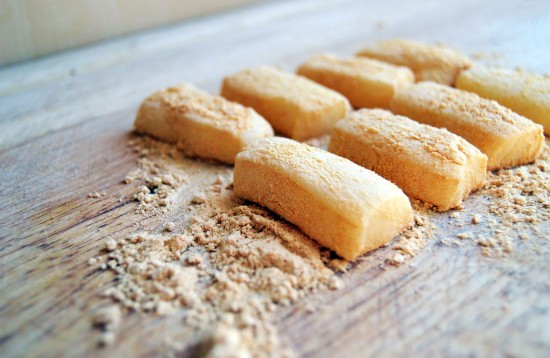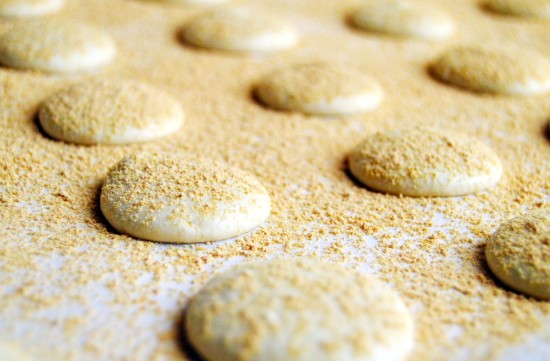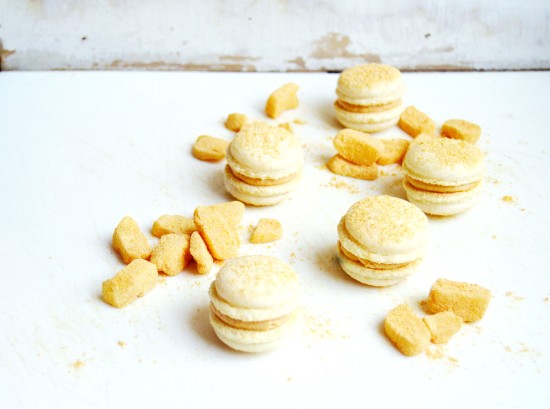 Have you ever tried Korean rice cakes, called Tteok (떡)? I’m not talking about the dried up, crispy American counterpart that we have in the states. Korean rice cakes are soft, chewy and if you’ve ever had mochi, they are very similar in texture. Korean rice cakes come in a variety of flavors and this one is injeolmi (인절미) flavored. It’s covered with roasted soybean powder and has a toasted, nutty taste. Since this past week was the Korean New Year, I thought I’d add a little Korean flair to my usual macarons. A good macaron has a light delicate shell that breaks into a slightly chewy interior. This macaron is slightly chewier due to the small piece of injeolmi in the middle.
Have you ever tried Korean rice cakes, called Tteok (떡)? I’m not talking about the dried up, crispy American counterpart that we have in the states. Korean rice cakes are soft, chewy and if you’ve ever had mochi, they are very similar in texture. Korean rice cakes come in a variety of flavors and this one is injeolmi (인절미) flavored. It’s covered with roasted soybean powder and has a toasted, nutty taste. Since this past week was the Korean New Year, I thought I’d add a little Korean flair to my usual macarons. A good macaron has a light delicate shell that breaks into a slightly chewy interior. This macaron is slightly chewier due to the small piece of injeolmi in the middle.

 You start off by making some injeolmi. It sounds more intimidating than it really is. You just mix some sweet rice flour, salt, sugar and water, cook it in the microwave, pound it and cut it up. You can see the step by step here. Once done, you make your basic macaron shells with a dusting of the roasted soybean powder. Then mix in some roasted soybean powder to your vanilla frosting. The components do not take that much longer than your standard macaron.
You start off by making some injeolmi. It sounds more intimidating than it really is. You just mix some sweet rice flour, salt, sugar and water, cook it in the microwave, pound it and cut it up. You can see the step by step here. Once done, you make your basic macaron shells with a dusting of the roasted soybean powder. Then mix in some roasted soybean powder to your vanilla frosting. The components do not take that much longer than your standard macaron.

 I originally attempted to make injeolmi macaron shells by substituting some of the soybean powder for the almond flour and it did not turn out well. Unlike cocoa powder which acts a lot like flour, soybean powder seems to suck up liquid easily. In the end I ended up with a whole batch of no-footed dense macaron shells. Not good. Not good at all. Just wanted to share what didn’t work me just in case you decide to try for yourself!
I originally attempted to make injeolmi macaron shells by substituting some of the soybean powder for the almond flour and it did not turn out well. Unlike cocoa powder which acts a lot like flour, soybean powder seems to suck up liquid easily. In the end I ended up with a whole batch of no-footed dense macaron shells. Not good. Not good at all. Just wanted to share what didn’t work me just in case you decide to try for yourself!

Injeolmi Macarons
Injeolmi Macaron Shells
Ingredients:
212 g. almond meal
212 g. powdered sugar
172 g. egg whites, divided to 82 g. and 90 g (aged, if possible)
236 g. sugar
158 g. water
roasted soybean powder (for dusting)
Instructions:
- Line two baking sheets with parchment paper or silicone mats.
- In the bowl of a food processor, add the almond meal and powdered sugar and pulse until thoroughly combined.
- Sift the mixture over a large mixing bowl, throwing out the lumps as they appear. Add 82 g. of the egg whites and stir until you get a thick mixture.
- In a small pot attached with a candy thermometer, combine the sugar and water over medium heat and boil until the syrup reaches 200˚F.
- Once the syrup reaches 200˚F, start whipping the remaining 90 g. in the bowl of your stand mixer with the whisk attachment on medium speed until soft peaks are reached.
- Once the syrup reaches 248 ˚F, remove the pot off the burner and slowly pour the syrup down the side of the mixing bowl with the egg whites on medium speed.
- Once the egg whites are fully incorporated, increase the speed to medium high until egg whites form glossy, stiff peaks.
- Mix a ⅓ of the egg white mix to the almond mixture and stir together until the batter is slightly lighter and less pasty. From then on, fold in ⅓ of the egg white mixture at a time until the mixture “flows like magma”. The mixture should be smooth and run thick ribbons off the spatula.
- With a pastry bag fitted with a ½ in. plain tip, pipe 1¼ – 1½ in. rounds.
- The piped batter may have peaks but should smooth away in a minute or two.
- Let the batter stand until the tops of the macarons are dry to the touch, about 30 minutes to 1 hour.
- Dust roasted soybean powder onto the macaron shells before putting into preheated oven.
- Preheat the oven to 275-325˚F. If your oven tends to run hot go for 275˚F, if not then 325˚F.
- Bake 10-13 minutes, until the feet are formed and the tops are smooth. The batter is done when you slightly wiggle it and it starts to come off of the parchment paper / silicone mat.
- Let cool and fill with injeolmi frosting with a small piece of injeolmi in the center.
Injeolmi Frosting
Ingredients:
½ c. whole milk
3 tbsp. flour
⅛ tsp. salt
4 oz. (1 stick) unsalted butter, room temperature
½ c. sugar
1 tsp. vanilla extract
⅓ c. roasted soybean powder
Instructions:
- In a small pot over medium heat, whisk milk, salt and flour until combined.
- Continuously whisk mixture until thickened to a pudding like consistency.
- Once thickened, strain through a mesh strainer into a bowl with a spatula to remove lumps.
- Place a piece of plastic wrap on top of the flour mixture (to prevent skin from forming) and put bowl into the fridge until fully cool.
- In a mixer bowl fitted with the whisk attachment, mix the sugar and butter on high speed until fluffy and pale about, 5-10 minutes.
- Add the chilled flour mixture and continue to whip on high speed until the sugar is completely dissolved and the mixture is no longer gritty, about 5-10 minutes.
- Add the vanilla extract and roasted soybean powder and mix until combined.
Injeolmi
Ingredients:
1 c. sweet rice flour (glutinous rice flour)
¼ tsp. kosher salt
2 tbsp. sugar
¾ c. water
roasted soybean powder (for dusting)
Instructions:
- In a microwave safe oven bowl, add sweet rice flour, salt, sugar and water and mix until homogenous. Cover with plastic wrap.
- Cook in microwave for three minutes on high.
- Mix with a wooden spoon and re-wrap and microwave on high for another minute.
- Pound the rice cake dough for 3-5 minutes with a wooden spoon until you hear the popping sound of the bubbles in the rice cake dough.
- On a cutting board, spread a generous amount of soybean powder and transfer the rice cake dough on top of it. Dust more soybean powder on top and smooth into a small rectangle.
- Cut into bite sized pieces for eating right away. For the macarons, cut into tiny squares that would fit into the macaron shell.
*Macaron recipe adapted from Bouchon Bakery by Thomas Keller, Sebastien Rouxel.
** Injeolmi recipe adapted from Maangchi.


My my, back with a bang aren’t we?
LOVE it! All if it.
Ohh wow! These are sooo ingenious and incredible! I would never have thought of putting a rice cake inside a macaron! I think the textures (crunchy and chewy) would be really interesting. This makes me wonder if it’d be possible to incorporate a Japanese mochi filling for a macaron as well – it has a similar chewy texture to tteok, but it’s sweet and perfect for a sugary confectionary like macarons 🙂
It’s amazing how similar it tastes to tteok and a japanese mochi filling sounds like a really smart idea!
This looks totally amazing! I was wondering how you stored these macarons. When you refrigerated or froze them did the mochi in the middle harden?
Hi, Diana! Tightly stored in the fridge they’re good for about a day or two. Any longer, the mocha will harden. 😞